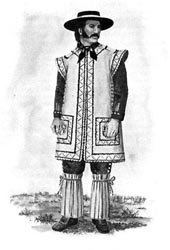Name Jose Ortega | ||
Gradus ad parnassum - Entrevista a José Francisco Ortega
José Francisco Ortega (1734 – February 1798) was a Spanish soldier and early settler of Alta California. A member of the Portola expedition in 1769, Ortega stayed on to become the patriarch of an important Californio family.
Contents
- Gradus ad parnassum Entrevista a Jos Francisco Ortega
- Early life
- Alta California
- Retirement
- Family
- References
Early life
Ortega was born in 1734 at Celaya, Guanajuanto, New Spain, where he worked as a warehouse clerk. Little else is known about his youth. In 1755 he enlisted and served at the Royal Presidio at Misión Nuestra Señora de Loreto in Baja California. In 1759 Ortega married María Antonia Victoria Carrillo (ca. 1741 - May 1803). Some time after being promoted to sergeant, Ortega left the army to mine in Baja California and became alcalde (mayor) of the mining camps placed on the peninsula. Ortega rejoined the army in 1768, recruited by Portola to join his expedition.
Alta California
Sergeant Ortega was the chief scout during the second phase of Gaspar de Portolà's land expedition to explore and extend the northern boundary of Las Californias. After establishing a base at San Diego in July, 1769, Portola led a reduced party that pushed on to the north. At the northern extreme of that march, Ortega led a scouting party that encountered San Francisco Bay on November 1, 1769, and was one of the first Europeans to see the bay.

In 1773 Ortega became Lieutenant and Commandant of the Presidio of San Diego, a post he held until 1781. Previously he was Acting Commandant from July 1771 in the absence of Pedro Fages. As Commandant he went with Fray Fermín Lasuén and twelve soldiers to explore the site chosen for Mission San Juan Capistrano. Ortega was a favorite of the missionaries, including Junípero Serra. In the spring of 1782, Ortega was on the expedition that founded Mission San Buenaventura and the Presidio of Santa Barbara. Ortega became the first Commandant of the Presidio of Santa Barbara that year, and remained until 1784. During 1787–1791 he was Commandant of the Presidio of Monterey,and in 1792 the Commandant of the Presidio in Loreto.
Retirement
In 1795 he retired as brevet captain with 40 years of service. Ortega was given a Spanish "land concession" in 1794, which he named Rancho Nuestra Señora del Refugio (Rancho Refugio) near Santa Barbara. He built his ranch here, but didn't enjoy it long. On February 3, 1798, Ortega fell from his horse and died at age 65 near the Indian village of Casil at Refugio Beach. He was buried at Mission Santa Barbara the following day.
Family
Ortega's descendants became one of the prominent Californio families. His son Ygnacio was the 1809 grantee of Rancho San Ysidro. Granddaughter Maria de Guadalupe married the naturalized American Joseph John Chapman. Granddaughter Maria del Pilar Ortega married Santiago Argüello, alcalde of San Diego and grantee of the Rancho ex-Mission San Diego and the Rancho Tijuana. Granddaughter Maria Soledad Ortega married Luis Argüello, the first native-born governor of Alta California. Another granddaughter married Scottish immigrant John Gilroy, namesake of Gilroy, California.
